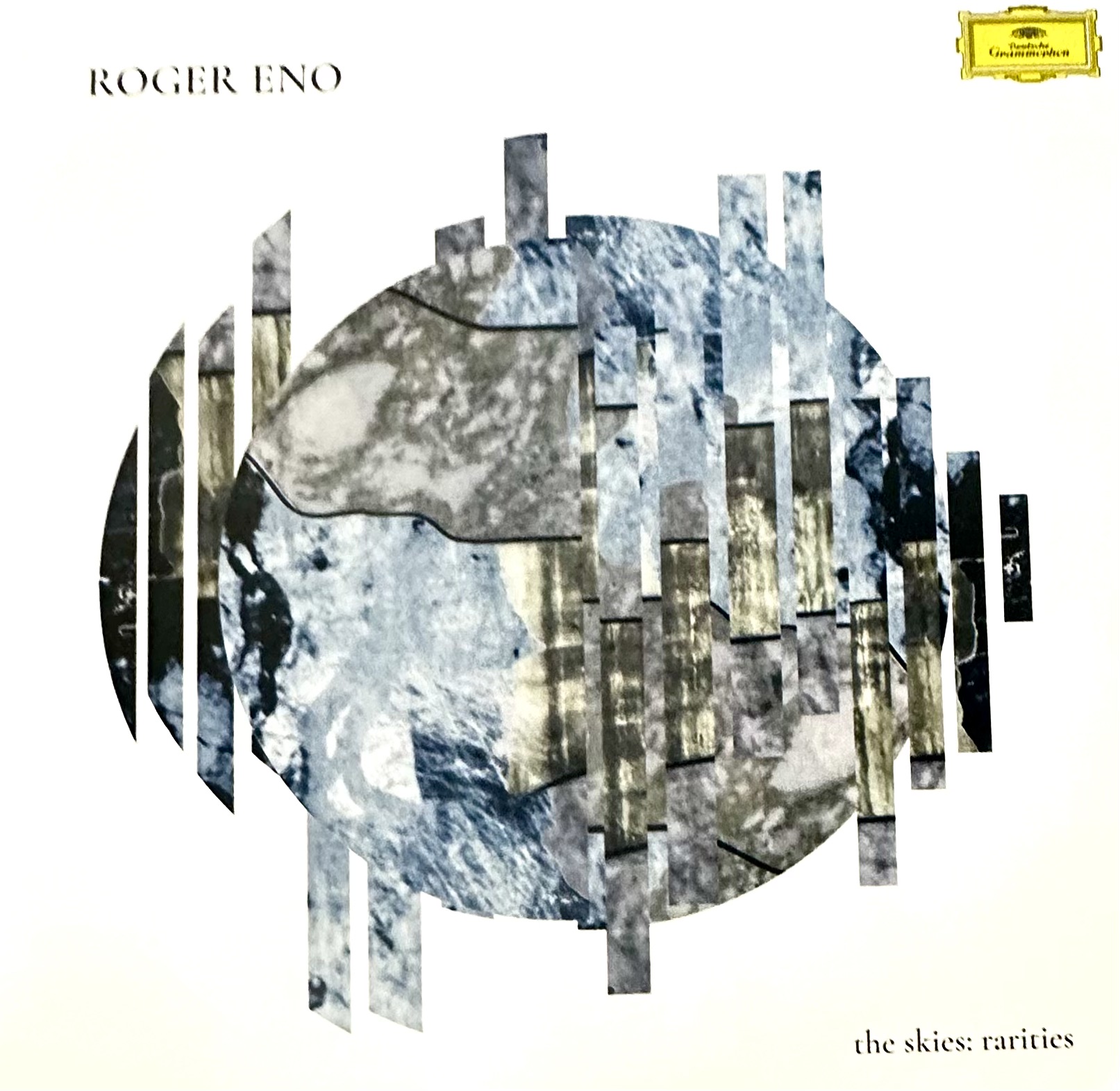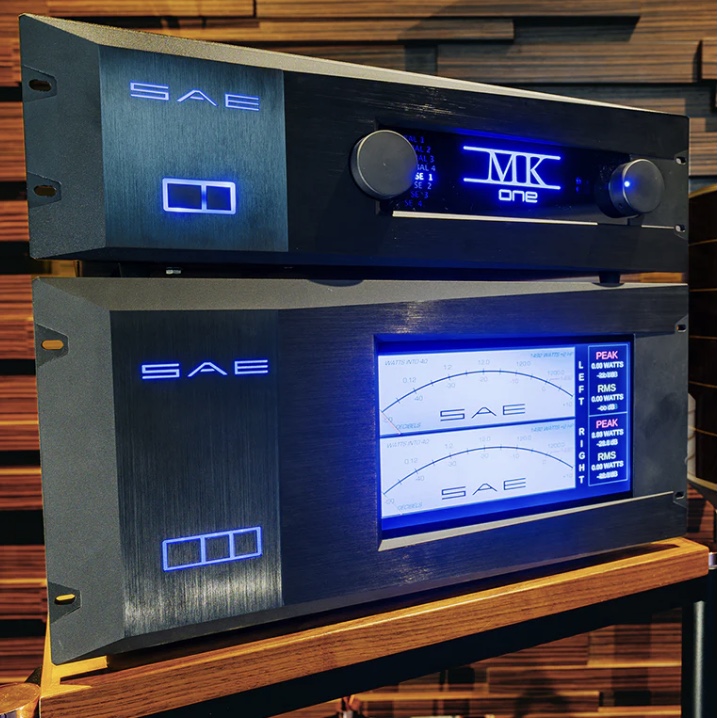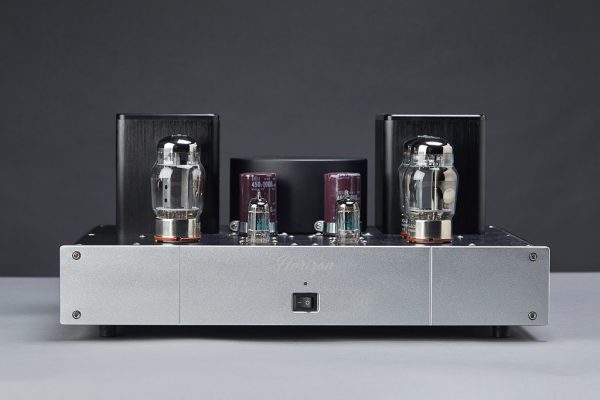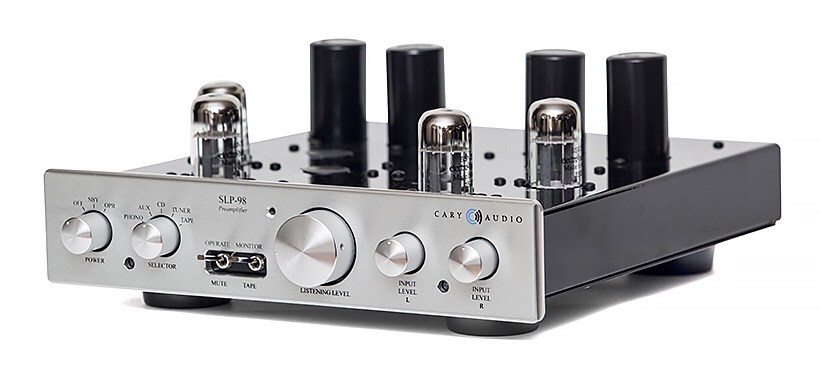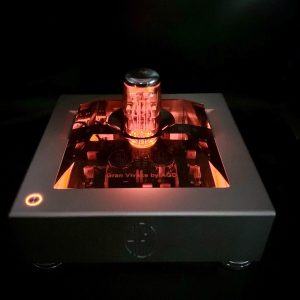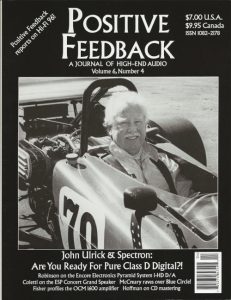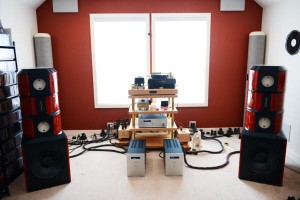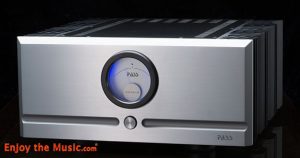Okay everyone! Time for the obvious disclosure! How could I not want to review an amplifier that emblazons my name right on the front of the amp in such fashion? Just ignore that Mc part. This is truly a Gary amp!
I was a bit surprised when the unit showed up at my door as I completely spaced on doing the review. (Let's hand that off to advanced age.) So I unpacked the amp from its shipping container and set it in between my mono blocks, installed the tubes, powered it up, and we were off to the McRaces!
This amp is the golden child of Mike McGary, a boutique builder based in Gainesville, GA. First thing I noticed about the amp was the fit and finish. It was exemplary! No sharp edges, a tight fitting cover to the chassis, and a very upscale back-lit logo on the front. Not laser cut in the face plate, but rather a molded logo inset into a laser cutout. Very classy indeed!
Here are the important specs for the unit as supplied by Mike:
- 30 Watts Per Channel (RMS) Low Distortion, 40 Watts Per Channel (RMS) Waveform Clipping (8 Ohm Load)
- 20Hz – 20kHz bandwidth
- Signal-to-noise ratio: greater than 85dB unweighted/unfiltered & referenced to full rated output power at 1kHz
- 4, 8, and 16 ohm output taps utilizing gold plated binding posts
- Gold plated RCA input connectors
- American made 13-Gauge steel enclosure…powder coated throughout (mint green metallic base with satin black top plate)
- Ceramic tube sockets (attached directly to the chassis)
- Point-to-point handwired with 16-gauge Teflon insulated silver plated copper wire, and using Cardas silver solder for all electrical connections with star grounding employed
- Detachable IEC Pangea power cord provided, or optional custom manufactured McGary Audio reference power cord using Wattgate connectors and 12 gauge Teflon insulated silver plated copper wire (please inquire)
- Tube complement: (2) NOS General Electric input (6BQ7A) and (2) driver (6SN7GTB) vacuum tubes, (4) new Russian KT77 matched Gold Lion output vacuum tubes
- Self-bias output tubes require no bias adjustments, and configured for Ultralinear operation
- Dimensions: 13" x 17" x 8.5" (WDH)
- Weight; 46lbs
- Power: 120V-60 Hz/240V-50Hz (electrically configurable, please inquire if purchasing product for use outside the USA)
- Electrical Engineer Designed and Handmade in Gainesville Virginia with a (transferable) Lifetime Warranty (excluding the vacuum tubes which come with a 90 day warranty from date of purchase)
- Color options for the SA 1 amplifier enclosure, top cover plate and the transformers can be customized for an additional cost…please inquire.
First off this amplifier, with a rating of only 30 watts per channel, sounded much larger and more powerful than the 30 watts would suggest. This is an amp that provides music with a powerful punch. At roughly one third volume the amp filled my not so small 33 foot x 18 foot room with 23 foot ceilings with plenty of punch, delicacy, presence, soundstage width, depth and height. It is very, very rewarding to have a unit like this in your system at the current sub $4000 mark. Special indeed. As mentioned above you can spec different colors for the case and even for the logo backlight. BLUE!
One of the very first things I noticed about the amp was the placement on the front panel of the RCA connections. When I inquired about this (purely an aesthetic issue) Mike responded, "I placed the inputs in/on the front of the unit because they are single ended inputs versus the balanced (XLR) type. By keeping the single ended inputs away from the power transformer and power supply circuitry, there is less chance of the inputs inducing stray emi power emissions and generating noise at the input tube located in the front of the amplifier (...and then amplified).
"Some like/approve this (from a good engineering practice)... while others have complained due to aesthetics. For the SA 2 amp, I plan to use balanced XLR inputs located on the rear panel and provide adapters to convert to single ended RCA."
Sound reason for the design. It is a bit odd to see the interconnects wrap around the amp to the front side but after a while I barely noticed it at all.
As I stated at the beginning the fit and finish on the unit I received was first rate top to bottom. the Golden Lion tubes were a plus and are the standard issue.
So how does this unit perform. Well lets get into that shall we... .
(Disclosure - As I began to write my review I was interrupted by the need to fulfill a promise to Paula that took two weeks out of my writing time. We went to Hawaii for our 30th anniversary! Ironically on Makapu'u beach I found myself thinking about the McGary amplifier and how much of an impact the amp had made on my system during the time it was in the system. Not the type of thing you want to admit to the wife on a trip where you renewed your vows and were to be totally focused on each other. Thankfully it was a fleeting thought as I stood waste deep in the turquoise and blue waves.)
Now where was I? Oh yes the sound that was produced by the McGary! Aside from the normal (okay a rather tired saying I'll admit but true none the less) warmth of tube amps, it proved itself to be rather neutral and invisible. Basically it did not seem to add anything or take away anything from the music used during the review. I am more than slightly familiar with my listening stalwarts for a very good reason. I can generally hear any variances in the delivery when interjecting a new component in the mix. When it comes to a number of components they will carry their own sonic signature that carries into the music. CD players, cartridges, speakers, even tape machines can certainly have sonic signatures that are immediately noticeable. I have had my Envoys out for repair for a few months now and in their place have been my reworked Quicksilver KT88s with Sophia Blue Bottle KT88 tubes. I will have to say I have missed the Envoys a lot less than I thought I would with these KT88s in their place. Going from the Quicksilvers to the McGary was not a giant switch in tube level or overall architecture. The McGary KT77s were not the quantum leap of going from a 300B based amp or the 211 based Envoys.
In essence the overall presentation didn't draw any attention to itself and quite actually just disappeared into the soundscape as though I had not made any significant change at all. That's not to say it sounded the same or better, but simply just presented the music in a way that didn't jump out at me as hugely different as some components have in the past. After a good deal of time listening I did find myself noticing a bit of missing bottom end thump that the 88s posses and some of the liquidity of vocals that the Sophias produce. Then again we are talking about a quartet of tubes that are considerably more expensive than the Golden Dragon KT 77s. We are talking about a really good set of Golden Lion tubes that run $180 for a matched quad versus $600 for the Sophias. (Totally unrelated and unsolicited, if you have a KT88 based amp, buy the Sophia Blue Bottle 88s)
So taking the McGary SA-1 on its own merits rates rather high. This is an amp that provided hours and hours of balanced delivery. Strong bottom end without bloat and excessive bloom, smooth vocals, and sizzling high end without grain and edge. Not once did I find myself making changes in the setup to overcome some level of overly bright top end or heavy handed bass delivery. Once it was set up and run in I never touched it until I had to pack it up and send it back (literally the day before I left for Hawaii).
I recently brought back an older playlist to change things up a bit. Staleness is a writers arch nemesis, so rotating the list a few times a years certainly keeps things interesting.
A recent reintroduction to my review queue is the Del Amitri tune "Driving With The Brakes On" from the 1995 release Twisted (A&M Records). Del Amitri, for those unfamiliar, is a very underrated Scottish band. Over the years the lineup has changed with the exception of bassist and lead singer Justin Currie and guitarist Iain Harvie. They had a couple of US charted songs in the 90s. "Roll With Me" reached 10 and "Always The Last To Know" which hit 30 on the US charts. Overall, one of the best bands I have ever heard, and seen in concert!
"Driving With the Brakes On" is an acoustic track that has a very lilting melody supporting very bittersweet lyrics about the difficulty of keeping relationships moving in the right direction. The main repeated line is "it's hard to say you love someone and it's hard to say you don't." Perhaps the most distilled commentary on the difficulty of keeping a relationship and ending one. Suffice it to say it is a rather impactful song, at least to this listener. Underscoring the entire track is Justin's acoustic guitar. It utilizes interesting chord modifications that add definite sparkle, and when presented correctly make you become aware that the chords all have diminished and add 9th notes, altering the normal delivery of the chord structure. That probably makes as much sense to an engineer who creates amps as the language of that trade tends to make to listeners. The point is that a musician picks up on those things, and when they are drawn to their proper place in a song during the reproduction process, it is a bit magical. I picked up on it immediately with McGary driving the music. It put a rather satisfied smile on my face! It is that detailed presentation of an instrument that goes beyond delivering the instrument as whole, but rather the individual strings, the proper tone of the wood, and in extreme instances the gauge of the strings and the material that makes up the bridge and nut and even the make and model of the guitar (yes they have that much of an individual sonic signature if not altered by effects). I was rather impressed that the McGary SA-1 delivered most of those nuances. Also the pain of the lyrics as delivered by Justin go straight to the gut of anyone who has found themselves in that precarious positions of being in a relationship on the ragged edge. His voice has a subtle way of presenting pain in his singing. This amplifier did a superb job of delivering that subtlety. A great start to the formal listening process and a good omen of listening to come.
Joan Armatrading's "Show Some Emotion" from the album of the same name (A&M Records) is clearly the star track on an album that received some harsh criticism for being a rehash of previous works. Although widely hailed as being Britain's answer to Joni Mitchell, this, her fourth album, failed to live up to the heavy expectations. That being said, I happen to like it as much as her previous album Joan Armatrading. I rate this as one of her best overall songs, with a decidedly jazz groove and a lot of snap and pop. We can thank Glyn Johns for the excellent production and choice of musicians that support Joan. David Kemper provides very solid drumming with a good deal of drive. He provides the base for the rest of the artists to cut loose with significant energy. Dave Markee's bass playing is both solid, driving, and subtle. Jerry Donahue provides some very tasty electric guitar playing that perfectly blends with John Bundriks exceptional Hammond B3 playing, there in the forefront, but not taking anything away from Joan's guitar work and vocals, both of which are superb! Joan has a very distinctive voice and her vocal timing and phrasing are also very unique. On this track the kick drum was right there keeping things hopping without any bloat, and the cymbals were bright, sizzling, and the decay was right on the money. The bass was tuneful and snappy. Running right in time with the drumming and laying the other half of a rather energetic rhythm section, the guitar was clean, devoid of excessive effects and subtly perfect. Smooth presentation with enough detail I could follow the picking strokes of each note (important to a guitar player, even a poor one like me). The Hammond organ just filled the spaces in a beautiful way that only a Hammond run through a Leslie speaker can do. Yes you can tell the speaker system delivering a Hammond or maybe more precisely when the Leslie is not in the mix!
On top of that stellar backing group Joan's vocals are just perfect. Breathy, delicate, with a smooth delivery that is just plain sweet. She shifts through a spectrum of notes that would cause other singers to have difficulty. On this track, and through this amp, it simply sounded effortless as it should. Parts of the vocals possessed a sense of urgency that comes through appropriately when getting the listener to understand the importance of showing some emotion. She seamlessly slides between soft presentation of expression and the harder delivery of urging the listener to action. Just a wonderful presentation and with a beautifully imaged soundstage that reached way beyond the placement of the speakers without losing that important center placement of the vocals. Kudos!
On the track "One Headlight" from the Wallflowers sophomore album Bringing Down the Horse (Inerscope/Polymor). This is a track that really shows the maturing of Jakob Dylan's writing, musicianship, and singing. Confession, I have always admired Bob Dylan's writing. Some of my all-time favorite songs were penned by the guy, but I always preferred listening to someone else sing them (noted exception "Lay Lady Lay"). I find the younger Dylan far more vocally palatable.
"One Headlight" is pushed through its paces by some really strong percussion courtesy of Matt Chamberlain. The steady snare pop that drives the song is crisp with just a bit of a hint of the actual metal snares coming though when the delivery is right. The droning bass of Greg Richling gives it just the right support for the organ and guitar parts and Jakob's slightly subdued hoarse but musically perfect vocals. Breathy is a good description, and it fits the lyrics so perfectly. It oozes melancholy and a slight detachment from the story line as though he is fed up with his surroundings and is a slightly detached narrator, and all that comes through perfectly thanks to the McGary. I found myself smiling though the playing of this track which I did a number of times to make sure I was actually hearing all the detail correctly. I was! That is when reviewing is truly fun and satisfying.
Big Star was a group that I listened to back in my teen years. they broke on the scene in 1971 with a debut album titled Number 1 Record (Ardent Records). One of the standout songs from the album, at least to me, was the song "Thirteen." The track is an acoustic lament about being a young teen in love/lust and the problems, trepidation, and ultimately the heartbreak that comes with young love lost. Stark in production with only acoustic guitar, bass, and vocals, the song reeks of teen desperation and disappointment. Written by a co-founder, the late Alex Chilton, it is a beautiful reminder of how important those first serious relationships are at the time, and lay the foundation for how we relate throughout life. Chilton's vocals take on that tone of uncertainty and timidity. He is supported with beautiful and lilting background vocals from co-founder / guitarist / vocalist Chris Bell, and bassist Andy Hummel. The sentiment and emotion of Alex's vocals come through so directly and so impactfully that you are instantly reminded of all the awkward moments that are filled with pubescent anxiety at the age of thirteen that most all of us lived through. For any system to be able to bring you into that world so effectively is really a stellar accomplishment. On this track I found myself listening over and over again for two reasons. First the track is only 2:34 long, and secondly and perhaps more importantly, it is so honest and relatable that I found the delivery within the system as pushed by the McGary SA-1 so enthralling. It hit me so deeply as I was reminded of my own experiences, and my first and second attempts at true love both ending in a shattered heart. I felt every bit of it come through the McGary SA-1amp and into my soul. At the end of the day, isn't that why we listen? Isn't that what we all want from our gear? That personal, deeply impactful, and sometimes gut wrenching trip into a world only entered through musical memories? If you are at all like me your life also may be documented down to the hour by songs. I can tell you almost to the time and day the first time I heard songs because they were an intricate part of my life.
If you have not heard, or heard of PSMS you may be missing out on one of the best Prog Rock groups to ever get together. The band consists of Mike Portnoy on percussion, Derek Sherinian on keyboards, Tony McAlpine on guitar and Billy Sheehan on bass. All are accomplished performers, side men, group members of other groups, and musical geniuses.
The live track "Line In The Sand" from their live concert Live At Zeppelin Tokyo 2012 will certainly cook any system. Starting with Mike Sheri Nina's synthesizer solo that brings back images of a robbed Rick Wakeman taking every keyboard player to school on the synth. The intro rolls into a great flight of talent as McAlpine's 8 string guitar is supported by the incredible rhythm section of Billy Sheehan's bass and Mike Portnoy's dynamic drumming. This song will put any system through its paces, and the McGary SA-1 handled it with an ease that defied its modest cost. All the slam and sizzle from Portnoy's drums steaming along with Billy Sheehan's complex bass lines lifting up brother Derek's upper keyboards, all gave the perfect support for McApline's singing guitar lines. Detail layered on top of detail, and nothing smothered by the smear that can come with live performances like this. I fed this track from a Tidal Hi Definition stream through my iPad. This is something I have just recently started using. I have always preferred as much analogue source as I can get when doing critical listening along with a fair amount of CD source. I have to admit that the feed just sounded outstanding through the system with the McGary SA-1 driving it all.
Perhaps not the most technical and biting way to review a piece of gear, but at the end of the day what I want from an audio component is for it to integrate well into my system, to be able to enhance the overall presentation, make me feel the songs deep in places I don't or cannot talk about, and to take me to a moment in time that either left me feeling elated, dumbstruck, or shattered. Catharsis is something we all indulge in to a degree, and mine is always a musical journey to get there and back. I do not listen and evaluate based whether or not the frequency response is precisely as stated (speakers being the sole exception and I do measure those things), S/N ratio is precisely as stated or that 40 watts precisely is being delivered across the spectrum. I listen to be transported. To be sucked into the performance and to be a part of the music in my own private way and spit out on the other side satisfied with the journey. That is what truly matters (and of course some requisite bragging rights).
What does any of that have to do with the McGary SA-1 Vacuum Tube Stereo Amplifier? Well to put it succinctly - EVERYTHING! Why? Because the McGary SA-1 provided every single bit of that no matter what I threw at it. It didn't seem to have a preference for source material or type, be it vinyl, tapes, CD, or streaming Hi Def files. It simply delivered what was there, and didn't seem to add or subtract anything at all. Not the last word in thundering tight bass, massive and explosive percussion, silky smooth midrange, or the brightest most sizzling high frequencies. Honestly at $3895 you will not get that. What you will get is an honest stereo power amp that will give you endless hours and hours of balanced, fairly neutral (in that warm tube way) presentation with 8/10ths of the max of amps costing 10 times more, ease of maintenance, a single cabinet that will fit nicely on most racks, or on the top of a nice cabinet that is easy on the eyes, and exceptional build quality. You will also enjoy the pleasant treatment of your favorite recordings leaving you with a whole lot of smiles, emotions, and left over money in your wallet! In my book that always makes for a must audition if you are looking for a power amplifier. Check it out. You will not be sorry that you did!
SA-1 Vacuum Tube Stereo Amplifier
Retail: $3985
Reference power cord
Retail: $250
McGary Audio, Mike McGary
8382 Pedigrue Court
Gainesville, VA 20155
703.894.7183
All images courtesy of the manufacturer.








